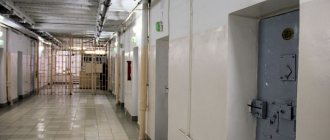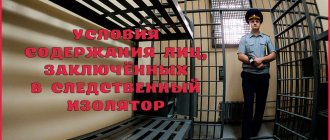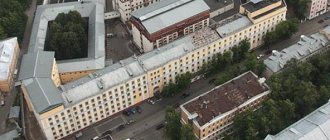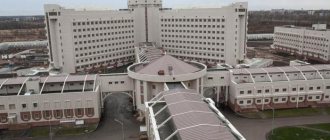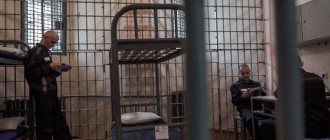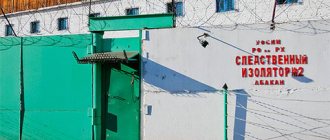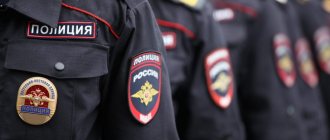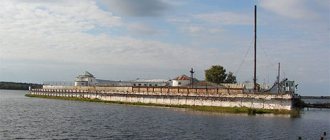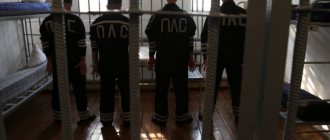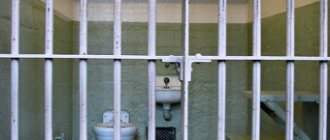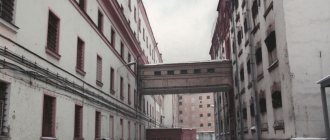St. Petersburg “Crosses” is one of the most famous and largest pre-trial detention centers in Russia. It bears the official name of FKU “SIZO-1” of the Federal Penitentiary Service of Russia for the city of St. Petersburg and the Leningrad region.
Built in 1892, the prison by the beginning of the 21st century had a number of problems related to overcrowding, lack of bedding and general dilapidation of the building. It was impossible to reconstruct the “Crosses” for two reasons: because of the law prohibiting the reconstruction of architectural monuments, which is the building of this institution, and because of the inability to transport prisoners anywhere during the renovation.
In 2006, a decision was made to build a new pre-trial detention center, and on December 22, 2022, all prisoners were taken to the new “Crosses” on the outskirts of Kolpino near St. Petersburg, where the institution remains to this day. This article is dedicated to the old legendary “Crosses”, partly thanks to which St. Petersburg is endowed with gangster fame. Let's consider why the prison is called that, what is the history of the founding of the pre-trial detention center, as well as which of the famous prisoners were imprisoned in this prison and other nuances.
What is it: characteristics of the old MLS in St. Petersburg
“Kresty” is a pre-trial detention center where suspects and accused of crimes are kept. They are not yet convicted, since the court has not yet pronounced a verdict against these persons. The only preventive measure in the form of detention was applied to them. Until the sentence passed by the judge comes into force, the person will remain in isolation and will not be transferred to another institution.
A pre-trial detention center is not a correctional institution; it is not intended to hold prisoners on a permanent basis. Serving a sentence in a pre-trial detention center is only possible if the sentence does not exceed six months.
Where is it located, the address of the pre-trial detention center: 195009, St. Petersburg, Arsenalnaya embankment, 7.
Telephone number of the duty station of this prison: 8 (812) 542-90-14.
The head of the institution is Colonel of the Internal Service Vadim Aleksandrovich Lvov. Reception of citizens on all issues is carried out every second and third Wednesday of the month from 11.00 to 12.00.
You must make an appointment in advance by calling 8 (812) 542-47-35. You can also ask questions to the management of the institution through the online reception https://www.kresty.ru/content/feedback/.
There is a Crosses page on the GUFSIN website – https://78.fsin.su/structure/sizo1.php. In addition, there is an official website of the institution https://www.kresty.ru/, groups on social networks https://vk.com/club2032202, https://vk.com/club1594317, https://vk.com/ kresty_spb.
Those held in a pre-trial detention center have the right to short-term visits (remember that long-term visits in a pre-trial detention center do not exist in principle), applications for which are filled out in the name of the head of the institution. The room's opening hours are from Monday to Saturday from 8.00-16.30 (lunch from 12.00-13.00).
Photos of St. Petersburg Crosses outside and inside
In the following photo you can see what this MLS looks like:
Institution infrastructure
Why is the prison called “Crosses”? The pre-trial detention center consists of two cruciform five-story buildings , the second building has the same structure as the first. This is where the name of the prison “Kresty” came from. This form was not chosen by chance: at the intersection of two corridors there is a platform from which you can see everything that happens at all four ends and on all floors, with the exception of the fifth, basement. This form is convenient not only because it is visible, but also because it reduces the possibility of prisoners communicating with each other.
The stairwells are covered with metal mesh to protect defendants from accidental injury or intentional suicide. Between the buildings of the detention center there is an administrative building, on the top floor of which is the Church of St. Alexander Nevsky.
The territory also contains four hospital buildings, a laundry, an icehouse , a dormitory for guards, a boiler room with an electric generator, an infectious disease building, a bathhouse and a kitchen with a bakery.
The service personnel at Kresty are the prisoners themselves, who go on duty according to a specific schedule.
“Crosses” on Arsenalnaya Embankment: history and future of the pre-trial detention center
After the “moving” of the pre-trial detention center to a new complex near Kolpino, “Crosses” still remains a security facility: divisions of the Federal Penitentiary Service and a colony-settlement are located here. And tourists were allowed into one of the buildings for one day. Report by Anton Zuman.
“Crosses” - the prison complex on Arsenalnaya Embankment began to be called that almost immediately, from the moment it was built in 1892. The people understood the meaning this way: the prisoner carries one cross himself, and crosses out his life with the other.
Anton Tsuman, correspondent: “Here is the center of one of the crosses - according to the architect’s idea, it had not so much symbolic as practical significance. This was the most progressive prison construction scheme at the end of the 19th century. It made it possible from here, from the center, with small forces to observe everything that was happening in the entire huge building.”
Even with the “moving” of the pre-trial detention center to a new complex near Kolpino, “Kresty” still remains a sensitive facility: units of the Federal Penitentiary Service and a colony-settlement are located here. And they decided to let tourists into this building for only one day. They even turned one of the cells into a museum.
Natalya Klyucharyova has been working in the structures of the Federal Penitentiary Service for almost 20 years, and is also the chief tour guide of Krestov. He constantly emphasizes that from the very foundation “Kresty” was not just a prison, but a “model” prison. The father of the writer Vladimir Nabokov, at that time a deputy of the 1st Duma, ended up here. The future head of the provisional government Kerensky, the future chairman of the Revolutionary Military Council Leon Trotsky. In general, “Crosses” was considered a “political” prison, having peculiarly inherited this status from the “Peter and Paul Fortress”. And already in the 30s they became a sad symbol of repression.
“Here, where I stood for three hundred hours, And where the bolt was not opened for me...” These lines of Anna Akhmatova’s “Requiem” were born at the walls of the “Crosses”, where every day she expected news from her son, Lev Gumilyov, who was arrested in 1938. Later he would become one of the pillars of Russian ethnography and oriental studies, but he would carry the memories of “Crosses” throughout his life.
Of course, what they call inveterate criminals also ended up in “Kresty”. Sometimes difficult. For example, the famous raider Lyonka Panteleev, who for the first time in the history of “Krestov” managed to escape from there. Or the robber Sergei Maduev, nicknamed “Chervonets,” who almost escaped with the help of one of the guards in 1991. Which was immediately reflected in Russian cinema.
With the collapse of the USSR, when old institutions were collapsing and new ones were just emerging, “Crosses” became one of the symbols of this time. In essence, it was a city within a city with its own orders, laws and ways of interacting with the outside world.
As journalist Evgeny Vyshenkov recalls, “Crosses” can rightfully be considered a reflection of all the inconsistencies of the nineties. When, for example, in a prison that was designed to accommodate 1,000 prisoners during construction, they began to hold 4 times as many.
Now the 90s have become a memory for some generations, and an unknown, almost ancient era for the generation that grew up in the era of gadgets. What can we say about the time of Akhmatova or Brodsky, who served his well-known sentence there for “parasitism”. And this story of what was once the largest prison in Europe is not over yet. Yes, it has partially changed its status. But for now, the leadership of the FSIN is in no hurry to voice concrete decisions regarding “Crosses.”
However, how you can use, for example, a vacant building can be suggested by numerous films and TV series, the filming of which took place within these walls. When an interrogation could be taking place literally in the next room from the film crew.
That is, the “Crosses” are so closely intertwined with the history of the city and the country that it is already completely clear: no matter how the premises of the former pre-trial detention center are used, the “Crosses” will remain “Crosses”. One of the most controversial, dark, and difficult. But still one of the components of a unique phenomenon called St. Petersburg.
Conditions of detention in the St. Petersburg pre-trial detention center
The isolation ward has 960 cells, each measuring 8 sq.m. Initially, during construction, they were planned to be single, but at the moment they contain 2-3 people. In the overcrowded nineties, the number of people in the cell reached 13. The cell contains two-tiered metal narrow bunks, a table, two chairs, and a shelf with personal belongings for each prisoner. Clothing and utensils are allowed “from the outside,” as well as books, personal items, and hygiene items.
The cell has a tap with running water and a toilet . Prisoners are provided with a bathhouse once a week, the duration of water procedures is 15 minutes. Maintaining cleanliness in the cell is the responsibility of the prisoners.
We invite you to watch a video about the conditions of detention in the pre-trial detention center:
Schedule
A prisoner's day begins at 6 a.m. and ends at 10 p.m. The ascent is signaled by the inclusion of bright lights and the radio. After this, it is forbidden to be on the bunk until lights out. Within an hour, prisoners make their beds, wash themselves, and tidy up their cells. Afterwards - breakfast and morning check.
At 9.30 the prisoners go on a walk, which takes place in a small room surrounded by concrete walls. There are bars and barbed wire above this room. Prisoners go out for walks in the same group as they are in their cells . During this time, their cells are subject to sanitization and inspection for storage of prohibited items.
At 12.00 – lunch, at 17.00 – dinner. During the day, prisoners can play board games, read books, write letters, which at the end of the day can be handed over to the prison guards to pass censorship, and engage in their hobbies. After lights out, the radio turns off, but the dim lighting remains.
Meals for prisoners
Prisoners in pre-trial detention centers are entitled to three hot meals a day . Porridge is served for breakfast, soup for lunch, and the second course is porridge again, but with the addition of meat. For dinner there is also porridge, but with fish or vegetables. Prisoners are allowed tea as a drink. For medical reasons, some prisoners are prescribed dietary nutrition, then chicken or beef, eggs and dairy products are added to their diet.
The food in the pre-trial detention center is very meager and monotonous, so food donations are welcome.
Work and study
Since the pre-trial detention center is a place of temporary detention for prisoners , the opportunity to work or study is not provided here. Although initially “Kresty” was a prison where all prisoners worked, in the 50s of the twentieth century it was completely self-sufficient due to the cardboard factory organized on the territory, and during the Great Patriotic War a number of samples of military equipment were developed here.
In 1964, there was a change of regime, and Kresty became an isolation ward, not a prison camp, so prisoners could no longer work here.
Religious issues
The attitude towards religion in “Crosses” is tolerant . Initially, during the construction of the prison, the Church of St. Alexander Nevsky was erected here, which became a club in Soviet times. But since the late 90s, work has been carried out to restore the church; in 2004, the altar and iconostasis were returned. Entrance here is always free for prisoners.
On holidays, services are held in the church; the pre-trial detention center is regularly visited by a priest who confesses and gives communion to the “parishioners.” The Bible and Gospel are freely available in the library, which are in great demand in the detention center.
Representatives of other faiths in the pre-trial detention center are also treated with understanding.
Entertainment and relaxation
In their free time, prisoners are allowed to play board games, which are sent in parcels and packages. The pre-trial detention center has a fairly large library, which is actively used. Employees note that books on religious topics and Russian classics are the most popular among prisoners.
Having free time also inspires prisoners to be creative. The most popular genres here are drawing (including icons), modeling from bread crumbs and crafts from paper and cardboard.
There is a club in “Kresty” where entertainment events are held for various holidays. The prisoners themselves act as decorators, artists and screenwriters here. In the same club, prisoners are sometimes shown various films.
Dates and visits
According to Article 89 of the Penal Code of the Russian Federation, prisoners can be granted no more than two visits per month, lasting up to three hours each. Visits are carried out under the control of guards and if there is an attempt to transfer prohibited items or information to the prisoner that may hinder the investigation or contribute to the commission of another crime, they are interrupted early.
To obtain permission to visit, you must write an application addressed to the head of the pre-trial detention center. In some cases, refusal is possible, most often this can happen due to the illness of the arrested person or in case of violation of the regime (or in an exceptional case when the investigation considers that your visit may interfere with the investigation).
Transfer of products and things
According to Art. 90 of the Penal Code of the Russian Federation, prisoners in pre-trial detention centers are allowed to receive any number of parcels, the weight of which must comply with the rules of mail, as well as transmission, with a total weight of no more than 30 kg per month. For prisoners suffering from serious illnesses (if there is a medical report from the institution’s doctors), there is no weight limit for parcels.
Items, substances and food products that may be dangerous to the life and health of people or used as weapons of crime are prohibited from being handed over to prisoners.
All types of alcoholic beverages , foods that require heat treatment, home-made canned food and perishable foods (dairy products, semi-finished products) are strictly prohibited for transfer.
All products must be factory produced with a stated expiration date.
It should also be remembered that all parcels and transfers undergo thorough inspection , so product packaging must be transparent, otherwise it will be opened. For example, some of the cigarettes will be broken, in case you hid something there.
Opening hours of the delivery bureau: from 8.00 to 17.00 (lunch from 12.00 to 13.00) daily, sanitary day is the last Sunday of each month.
If it is impossible to bring the package, then you can place an order at a local store , and then everything will be delivered directly to the cell, bypassing the inspection procedure, which is especially important for tobacco products. The order desk is open from Tuesday to Saturday from 8-30 to 16-30, lunch from 12-00 to 13-00.
The most relevant products for transfer are those that are a kind of currency in the pre-trial detention center: instant noodles, sugar, salt, and especially tea and cigarettes.
Among the things that are in great demand for donation at “Kresty” are: bed linen, towels, dishes and spoons (made of plastic or wood), underwear, tights, socks, personal hygiene products (soap, razors, toilet paper).
Punishment cell
For violation of the regime or disobedience to the staff of the pre-trial detention center, the prisoner is sent to the Penal Temporary Detention Isolator (SHIZO). In Kresti this is a room not exceeding 4 square meters, located in the basement, with a very small window near the ceiling. The prisoner is there alone, the bunks nailed to the wall are folded up for the daytime, time here has to be spent on your feet or on the damp and cold floor.
In addition, the daily ration in the punishment cell has been reduced. According to Article 118 of the Penal Code of the Russian Federation, the period of stay in a punishment cell should not exceed 15 days.
Features of the prison regime
"Kresty" is one of the most famous places of detention in Russia . One of the distinctive features of this place of deprivation of liberty is that since the 90s of the twentieth century, “Crosses” was the most overcrowded prison on the territory of the Russian Federation. At times the number of prisoners reached 12 thousand people.
There were 13 prisoners in 3 bunk cells, and they were forced to take turns sleeping. The air temperature in the cells reached 40 degrees and rarely fell below 30, and the stench, sweat, and smoke were added to this. This contributed to the development of unsanitary conditions and disease, and made prison conditions particularly difficult.
What do the cameras look like in Kresty?
The brick walls of Krestov, darkened by time, are strong even by modern standards. Not a single prisoner in the entire history of the prison managed to break them. The secret is simple - raw chicken eggs were mixed into the solution for them (but this, of course, is not certain).
The area of one chamber is 8 square meters. m . Although they were originally planned to be all single occupancy, in recent years they have held 3 people each. During the difficult years for the country in the 90s, as well as at the height of Stalin’s repressions, “Crosses” were literally overcrowded. Often 10-15 people were placed in cells. Prisoners were forced to spend time standing in horribly cramped conditions, like being on a crowded bus, and took turns sleeping.
The situation was aggravated by the fact that the cells could only be ventilated through a small window. By the way, through them, prisoners pass notes and small packages to their neighbors or to the outside world.
The situation in the cells until 2022 was little different from the original one. Except that iron bunks were installed. Many of these cells were once the refuge of various celebrities : Rokossovsky, Zhzhenov, Trotsky, Kerensky... It’s a pity that in the last 10 years of the prison’s existence, after the cancellation of excursions, there was only one way to get into them - by going to Kresty as a person under investigation.
One of the most recognizable places in “Crosses” is the vaulted tower in the center of each of the 2 buildings, a kind of “axis” from which all the corridors diverge. There is a net between the floors to prevent prisoners from jumping down and falling to their death.
Now that the old "Crosses" have been freed from prisoners, uncertainty hangs over them. There are debates about what purposes the buildings should be adapted for.
We talked more about what cells in prisons look like in a separate article.
We invite you to watch an informative video about Kresty prison:
History from the foundation
Construction of the “Crosses” began in 1884 by order of Nicholas II under the leadership of the architect A. Tomishko. The unusual shape of the insulator was his idea. According to the master’s idea, this form should remind prisoners of God, or symbolize the cross placed on their own destiny.
Solitary confinement cells were supposed to resemble a cell and have an environment conducive to repentance, prayer and correction.
Soon after its opening, the prison received its name as we know it. The project turned out to be successful and convenient, so it was later repeated in Samara and Chelyabinsk.
At the beginning of the 20th century, “Crosses” was considered an exemplary prison , made in the European style. The cells contained 1-2 people. The buildings were equipped with the latest technology of the time. They had flush toilets, ventilation, and central heating.
Before the revolution, the pre-trial detention center became almost entirely an institution for holding political criminals, although before that it had predominantly a criminal element. The era of Stalin brought a new popular article - “Enemy of the People.”
During the Great Patriotic War, most of the convicts and prison staff died.
Almost every day the territory of “Crosses” was bombed. The hunger and cold of the blockade claimed many lives. After the end of the war, the destroyed buildings began to be restored; in the 60s, old ones were restored and new blocks and production facilities were built.
The most difficult years in the fate of “Kresty” were the 90s , when the isolation ward was overcrowded. During this period, tension among prisoners was particularly strong, resulting in constant clashes between prisoners. Such clashes often led to murders.
By the end of the 90s, conditions in the pre-trial detention center improved. In “Kresty” the bunks were changed and the bathrooms were improved. In 2004, the Church of St. Alexander Nevsky was restored, the altar and dome crosses were returned to it. Unfortunately, due to the design features of the buildings, they are not subject to major repairs. Any redevelopment will lead to the destruction of the building.
We invite you to watch a video about the history of the pre-trial detention center:
Why is the prison called "Crosses"
One of the most famous prisons in Russia originates from a huge wine cellar organized by Empress Anna Ioanovna on Arsenalnaya Embankment in St. Petersburg. Later, the wine warehouse was converted into a prison. On this site in 1884, a huge prison complex for those times was erected by the hands of prisoners.
Louis Caravac. Portrait of Anna Ioanovna, 1730
The concept of the architect Antoni Tomiško was that the two main buildings of the prison were in the shape of crosses, connected by the Church of St. Alexander Nevsky . It is not surprising that the people call the place “Crosses”. The red brick buildings were supposed to remind prisoners of God's judgment and call for repentance.
In addition to aesthetic ones, the architect also decided on purely practical functions. The layout made it easier for jailers to control the corridors and the movements of prisoners along them. The most modern prison in Russia has adopted foreign experience. Western prisons are usually built on the principle of maximum openness and illumination of space.
At the beginning of the last century, the prison ensemble for 1000 people met all the then requirements for housing prisoners. Kresty was considered the most advanced prison in Russia. The prisoners were kept in cells of one or two people. The interior had central heating, ventilation and flush toilets.
The Krestov project was considered so successful that copies of the prison were later built in two more Russian cities.
Crosses. Source: wikipedia.org
The most famous prisoners
Over the years of its existence, many famous people have visited the walls of “Crosses” . Before the revolution, the Bolsheviks A.V. Lunacharsky, V.A. managed to visit “Kresty”. Antonov-Ovseenko, L.D. Trotsky. The latter even took his pseudonym after the name of one of the local guards.
In the 1930s, victims of Stalinist repressions convicted under Article 58 served their sentences here: historian L. Gumilyov, Marshal K. Rokossovsky, actor G. Zhzhenov. Later, the list of “star” prisoners was supplemented by the writer D. Kharms and the poet I. Brodsky.
History of prisons. Prison Crosses in St. Petersburg
In the relatively short history of its existence, the St. Petersburg prison “Crosses” has witnessed several coups d’etat. During successive eras of rule, the walls of this dungeon were visited by People's Will members, Bolsheviks, revolutionaries, then by ministers of the overthrown tsarist government, law enforcement officers, dignitaries, military and political figures of the abolished Russian Empire, and even later by representatives of science and culture repressed in the USSR, and finally - leaders of the criminal world of the 90s.
“Crosses” became part of the destinies of such famous personalities as the revolutionary and writer Porfiry Infantiev, the future Minister of the Provisional Government Alexander Kerensky, revolutionaries Leon Trotsky, Lev Kamenev and Anatoly Lunacharsky, the future Marshal of the USSR Konstantin Rokossovsky, the son of Anna Akhmatova Lev Gumilyov (future scientist-historian ), actor Georgy Zhzhenov (future People's Artist of the USSR), writer Yuli Berzin, poets Joseph Brodsky and Nikolai Zabolotsky.
Today, the old Kresty prison on the Neva embankment is half-abandoned. She was resettled back in 2022. Since December 1, 2017, the largest pre-trial detention center in Europe, Kresty-2, has been operating in the Kolpinsky district of St. Petersburg. And the old “Crosses,” according to media reports, are preparing to become the next Russian museum of prison life.
We are looking forward to this majestic architectural complex opening its doors to tourists, but in the meantime we invite you to learn more about the history of its foundation and operation.
